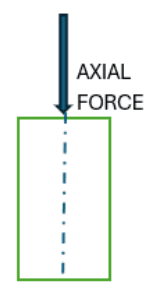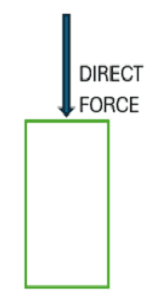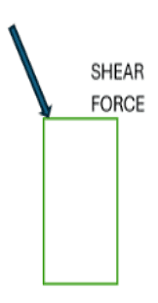Q1: Define Force.
Ans:A force is a push or pull applied on the body. The unit of force is N.
Q2: Name the types of stress.
Ans:
The types are:- ➔ Direct Stress
- ➔ Tensile Stress
- ➔ Compressive Stress
- ➔ Shear Stress
Q3: Write down the unit of stress in:
Ans:
| System | Measuring Unit |
|---|
| MKS | kg/m2 |
| CGS | g/cm2 |
| FPS | lbs/ft2 |
| SI | N/m2 |
Q4: Define Axial Force.
Ans:
The force acting at the centroid of an object is called axial force.
Q5: Define Eccentric Force.
Ans:
The force acting away from the centroid of an object is called eccentric force.
Q6: Define Stress.
Ans:
The stress produced as a result of shear force is called shear stress. Its formula is:
Q7: Define Shear Stress.
Ans:
The stress produced as a result of shear force is called shear stress. Its formula is:
Q8: Define tensile stress.
Ans:
The stress produced due to Tensile Force is Tensile Stress.
Q9: Define compressive stress.
Ans:
The stress produced due to Compressive Force is Compressive Stress.
Q10: Define Bending Stress.
Ans:The stress produced by Bending Moment is Bending Stress.
Q11: Enlist various modes through which forces affect structural members.
Ans:
Some of the modes are:- ➔ Tension
- ➔ Compression
- ➔ Shearing
- ➔ Bending
- ➔ Torsion
Q12: Differentiate between ordinary and pure bending.
Ans:A bending moment produced by forces that do not form a couple is ordinary Bending.
The bending moment produced by forces that form a couple is Pure Bending.
Q13: Define Neutral surface.
Ans:A neutral surface is the surface of a beam that does not undergo any tension or compression. At this surface, the force and its effects are zero.
Q14: What do you know about section modulus?
Ans:The ratio of Moment of Inertia and distance of extreme fibre from the centroidal axis is section modulus.
Q15: State any two postulates of bending theory.
Ans:
Two points are:- ➔ Beam is straight
- ➔ The material of beam is elastic
- ➔ Hook’s Law is applicable to the material of beam
Q16: State bending equation.
Ans:
 where
where
M = Bending Moment
I = Moment of Inertia
E = Young’s Modulus
R = Radius of CurvatureQ17: Define Direct Force.
Ans:
A direct force acts normal(perpendicular) to the object is called Direct Force.
Q18: Define Shear Force.
Ans:
A shear force acts tangent(angle other than 900) to the object is called Shear Force.






 where
where

